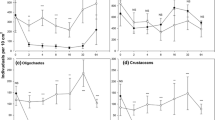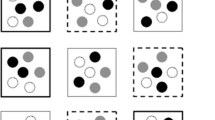Abstract
Increasing concerns about the ecological impacts of ongoing and possibly worsening blooms of the toxic, carcinogenic cyanobacteria Lyngbya majuscula in Moreton Bay, Australia, led us to assess differences in meiofaunal prey assemblages between bloom and non-bloom substrates and the potential dietary impacts of dense L. majuscula blooms on the omnivorous benthivore, the Eastern Long-finned Goby, Favonigobius lentiginosus and the obligate meiobenthivorous juveniles of Trumpeter Whiting, Sillago maculata. Marked differences in invertebrate communities were found between sandy and L. majuscula bloom foraging substrates, with copepods significantly more abundant (18.49% vs. 70.44% numerical abundance) and nematodes significantly less abundant (55.91% vs. 1.21% numerical abundance) within bloom material. Gut analyses showed that bentho-planktivorous fishes exposed to L. majuscula in captivity had consumed a significantly greater quantity of prey by both total number (P < 0.0019) and volume (P < 0.0006) than fish exposed to sand treatments. Thus, it is likely for such fishes that L. majuscula blooms increase rates of prey encounter and consumption, with consequent changes in trophic relationships through shifts in predator–prey interactions between small benthivorous fishes and their meiofaunal prey.







Similar content being viewed by others
References
Ahern KS, O’Neil JM, Udy JW, Albert S (2006a) Effects of iron additions on filament growth and productivity of the cyanobacterium Lyngbya majuscula. Mar Freshw Res 57:167–176. doi:10.1071/MF05022
Ahern KS, Udy JW, Pointon SM (2006b) Investigating the potential for groundwater from different vegetation, soil and land uses to stimulate blooms of the cyanobacterium, Lyngbya majuscula, in coastal waters. Mar Freshw Res 57:177–186. doi:10.1071/MF05115
Ahern KS, Ahern CR, Savige GM, Udy JW (2007a) Mapping the distribution, biomass and tissue nutrient levels of a marine benthic cyanobacteria bloom (Lyngbya majuscula). Mar Freshw Res 58:883–904. doi:10.1071/MF07065
Ahern KS, Udy JW, Ahern CR (2007b) Nutrient additions generate prolific growth of Lyngbya majuscula (cyanobacteria) in field and bioassay experiments. Harmful Algae 6:134–151. doi:10.1016/j.hal.2006.08.004
Ahern KS, Ahern CR, Udy JW (2008) In situ field experiment shows Lyngbya majuscula (cyanobacterium) growth stimulated by added iron, phosphorus and nitrogen. Harmful Algae 7:389–404. doi:10.1016/j.hal.2007.08.006
Albert S, O’Neil J, Udy JW, Ahern K, O’Sullivan C, Dennison W (2005) Blooms of the cyanobacterium Lyngbya majuscula in coastal Queensland, Australia: disparate sites, common factors. Mar Pollut Bull 51:428–437. doi:10.1016/j.marpolbul.2004.10.016
Anderson DM, Glibert PM, Burkholder JM (2002) Harmful algal blooms and eutrophication: nutrient sources, composition, and consequences. Estuaries 25:704–726
Andersson S, Persson M, Moksnes PO, Baden S (2009) The role of the amphipod Gammarus locusta as a grazer on macroalgae in Swedish seagrass meadows. Mar Biol 156:969–981. doi:10.1016/j.hal.2007.06.001
Arthur K, Limpus C, Balazs G, Capper A, Udy JW, Shaw GR, Keuper-Bennett U, Bennett P (2008) The exposure of green turtles (Chelonia mydas) to tumour promoting compounds produced by the cyanobacterium Lyngbya majuscula and their potential role in the aetiology of fibropapillomatosis. Harmful Algae 7:114–125
Beck MW, Heck KL, Able KW, Childers DL, Eggleston DB, Gillanders BM, Halpern B, Hays CG, Hoshino K, Minello TJ, Orth RJ, Sheridan PF, Weinstein MP (2001) The identification, conservation and management of estuarine and marine nurseries for fish and invertebrates. Bioscience 51:633–641
Campbell CE (1995) The influence of a predatory ostracod, Australocypris insularis, on zooplankton abundance and species composition in a saline lake. Hydrobiology 302:229–239
Capper A, Tibbetts IR, O’Neil JM, Shaw GM (2005) The fate of Lyngbya majuscula toxins in three potential consumers. J Chem Ecol 31:1595–1606. doi:10.1007/S10886-005-5800-5
Capper A, Cruz-Rivera E, Paul V, Tibbetts IR (2006a) Chemical deterrence of a marine cyanobacterium against sympatric and non-sympatric consumers. Hydrobiology 553:319–326. doi:10.1007/s10750-005-1129-x
Capper A, Tibbetts IR, O’Neil JM, Shaw GR (2006b) Feeding preference and deterrence in rabbitfish Siganus fuscescens for the cyanobacterium Lyngbya majuscula in Moreton Bay, south-east Queensland, Australia. J Fish Biol 68:1589–1609. doi:10.1111/j.1095-8649.2006.01048.x
Chesson J (1978) Measuring preference in selective predation. Ecology 59:211–215
Clarke KR, Warwick RM (1994) Similarity-based testing for community pattern—the 2-way layout with no replication. Mar Biol 118:167–176
Coull BC, Greenwood JG, Fielder DR, Coull BA (1995) Subtropical Australian juvenile fish eat meiofauna—experiments with winter whiting Sillago maculata and observations on other species. Mar Ecol Prog Ser 125:13–19
Cruz-Rivera E, Paul V (2000) Coral reef benthic cyanobacteria as food and refuge: diversity, chemistry and complex interactions. Proceedings of the 9th International Coral Reef Symposium, Bali, pp 23–27
Danovaro R, Scopa M, Gambi C, Fraschetti S (2007) Trophic importance of subtidal metazoan meiofauna: evidence from in situ exclusion experiments on soft and rocky substrates. Mar Biol 152:339–350. doi:10.1007/s00227-007-0696-y
Dennison WC, O’Neil JM, Duffy EJ, Oliver PE, Shaw GR (1999) Blooms of the cyanobacterium Lyngbya majuscula in coastal waters of Queensland, Australia. In: Charpy L, Larkum AWD (eds) Proceedings of an international symposium marine cyanobacterium. Bull de l’Institut Ocean, Monarco, pp 501–506
dos Santos GAP, Derycke S, Genevois VGF, Coelho LCBB, Correia MTS, Moens T (2009) Interactions among bacterial-feeding nematode species at different levels of food availability. Mar Biol 155:629–640. doi:10.1007/s00227-008-1114-9
Eggleston DB, Etherington LL, Elis WE (1998) Organism response to habitat patchiness: species and habitat-dependent recruitment of decapod crustaceans. J Exp Mar Biol Ecol 223:111–132
EHMP (2008) Ecosystem health monitoring program 2006–2007 Annual technical report. South East Queensland Healthy Waterways Partnership, Brisbane
Elmetri I, Bell PRF (2004) Effects of phosphorus on the growth and nitrogen fixation rates of Lyngbya majuscula: implications for management in Moreton Bay, Queensland. Mar Ecol Prog Ser 281:27–35
Fujiki H, Suganuma M, Yatsunami J, Komori A, Okabe S, Nishiwakimatsushima R, Ohta T (1993) Significant marine natural-products in cancer research. Gazz Chim Ital 123:309–316
Gamenick I, Rethmeier J, Rabenstein A, Fischer U, Giere O (1997) Effects of anoxic and sulfidic conditions on cyanobacteria and macrozoobenthos in shallow coastal sediments of the Southern Baltic Sea. Arch Hydrobiol 140:465–490
Garcia R, Johnstone RW (2006) Effects of Lyngbya majuscula (Cyanophycea) blooms on sediment nutrients and meiofaunal assemblages in seagrass beds in Moreton Bay, Australia. Mar Freshw Res 57:155–165. doi:10.1071/MF05053
Giere O (2009) Meiobenthology: the microscopic motile fauna of aquatic sediments. Springer, Berlin
Gyedu-Ababio TK, Baird D (2006) Response of meiofauna and nematode communities to increased levels of contaminants in a laboratory microcosm experiment. Ecotoxicol Environ Saf 63:443–450. doi:10.1016/j.ecoenv.2005.01.010
Hallegraeff GM (1993) A review of harmful algal blooms and their apparent global increase. Phycologia 32:79–99
Hua E, Zhang ZN, Zhang Y (2006) Meiofauna distributions at the oxygen minimum zone in Changjiang (Yangtze) River Estuary waters. Acta Oceanol Sin 25:120–134
Hynes HBN (1980) The food of freshwater sticklebacks (Gasterosteus aculeatus and Pygosteus pungitius), with a review of methods used in studies of the food of fishes. J Anim Ecol 19:36–58
Izumi AK, Moore RE (1987) Seaweed (Lyngbya majuscula) dermatitis. Clin Dermatol 5:92–100
Jacoby CA, Greenwood JG (1989) Emergent zooplankton in Moreton Bay, Queensland, Australia: seasonal, lunar, and diel patterns in emergence and distribution with respect to substrata. Mar Ecol Prog Ser 51:131–154
Krueck NC, Chargulaf CA, Saint-Paul U, Tibbetts IR (2009) Early post-settlement habitat and diet shifts and the nursery function of tidepools during Sillago spp. recruitment in Moreton Bay, Australia. Mar Ecol Prog Ser 384:207–219. doi:10.3354/meps07992
Lindholm JB, Auster PJ, Ruth M, Kaufman L (2001) Modeling the effects of fishing and implications for the design of marine protected areas: Juvenile fish responses to variations in seafloor habitat. Conserv Biol 15:424–437
Linke TE, Platell ME, Potter IC (2001) Factors influencing the partitioning of food resources among six fish species in a large embayment with juxtaposing bare sand and seagrass habitats. J Exp Mar Biol Ecol 266:193–217
Long SM, Ross OBH (1999) Vertical distribution of nematodes (Nematoda) and harpacticoid copepods (Copepoda: Harpacticoida) in muddy and sandy bottom of intertidal zone at Lok Kawi, Sabah, Malaysia. Raffles Bull Zool 47:349–363
Meyer HA, Bell SS (1989) Response of harpacticoid copepods to detrital accumulation on seagrass blades: a field experiment with beads Metis holothuriae (Edwards). J Exp Mar Biol Ecol 132:41–149
Nagle DG, Camacho FT, Paul VJ (1998) Dietary preferences of the opisthobranch mollusc Stylocheilus longicauda for secondary metabolites produced by the tropical cyanobacterium Lyngbya majuscula. Mar Biol 132:267–273
Osborne N, Webb P, Shaw GR (2001) The toxins of Lyngbya majuscula and their human and ecological health effects. Environ Int 28:381–392
Paul VJ, Nelson SG, Sanger HR (1990) Feeding preferences of adult and juvenile rabbitfish Siganus argenteus in relation to chemical defenses of tropical seaweeds. Mar Ecol Prog Ser 60:23–34
Pennings SC (1990) Multiple factors promoting narrow host range in the sea hare, Aplysia calfornica. Oecologia 82:192–200
Pennings SC, Paul VJ (1993) Secondary chemistry does not limit the dietary range of the specialist sea hare Stylocheilus longicauda (Quoy et Gaimard, 1824). J Exp Mar Biol Ecol 174:97–113
Pennings SC, Weiss AM, Paul VJ (1996) Secondary metabolites of the cyanobacterium Microcoleus lyngbyaceus and the sea hare Stylocheilus longicauda: palatability and toxicity. Mar Biol 126:735–743
Pittman SJ, McAlpine CA (2003) Movements of marine fish and decapod crustaceans: process, theory and application. Adv Mar Biol 44:205–294
Pittman S, Pittman K (2005) Short-term consequences of a benthic cyanobacterial bloom (Lyngbya majuscula, Gomont) for fish and penaeid prawns in Moreton Bay (Queensland, Australia). Estuar Coast Shelf Sci 63:619–632. doi:10.1016/j.ecss.2005.01.007
Queensland Department of Environment and Resource Management (2010) Moreton Bay Lyngbya monitoring updates. DERM Website. http://www.derm.qld.gov.au/environmental_management/coast_and_oceans/marine_habitats/lyngbya_updates/monitoring_update/index.html. Accessed 6 Sept 2010
Rieper M (1978) Bacteria as food for marine harpacticoid copepods. Mar Biol 45:337–345
Roelfsema CM, Phinn SR, Dennison WC, Dekker AG, Brando VE (2006) Monitoring toxic cyanobacteria Lyngbya majuscula (Gomont) in Moreton Bay, Australia, by integrating satellite image data and field mapping. Harmful Algae 5:45–56. doi:10.1016/j.hal.2005.05.001
Samson JC, Shumway SE, Weis JS (2008) Effects of the toxic dinoflagellate, Alexandrium fundyense on three species of larval fish: a food-chain approach. J Fish Biol 72:168–188. doi:10.1111/j.1095-8649.2007.01698.x
Sellner KG (1997) Physiology, ecology, and toxic properties of marine cyanobacteria blooms. Limnol Oceanogr 42:1089–1104
Skilleter GA, Cameron B, Zharikov Y, Boland D, McPhee DP (2006) Effects of physical disturbance on infaunal and epifaunal assemblages in subtropical, intertidal seagrass beds. Mar Ecol Prog Ser 308:61–78
Sutherland TF, Shepherd PCF, Elner RW (2000) Predation on meiofaunal and macrofaunal invertebrates by western sandpipers (Calidris mauri): evidence for dual foraging modes. Mar Biol 137:983–993
Thrush SF, Hewitt JE, Norkko A, Nicholls PE, Funnell GA, Ellis JI (2003) Habitat change in estuaries: predicting broad-scale responses of intertidal macrofauna to sediment mud content. Mar Ecol Prog Ser 263:101–112
Watkinson A, O’Neil J, Dennison W (2005) Ecophysiology of the marine cyanobacterium Lyngbya majuscula (Oscillatoriaceae) in Moreton Bay, Australia. Harmful Algae 4:697–715. doi:10.1016/j.hal.2004.09.001
Zaret TM, Rand AS (1971) Competition in tropical stream fishes—support for competitive exclusion principle. Ecology 52:336
Acknowledgments
We thank Craig Chargulaf, Angela Capper and two anonymous reviewers for their constructive and helpful comments. This project was partially funded by the Moreton Bay Research Station Community Scholarship. The authors would like to thank the brilliant staff at MBRS for their exemplary support throughout the project. The described experiments were conducted under the University of Queensland’s Animal Ethics Committee’s approval number CMS/816/08 and Marine Parks Permits QS2005/CVL319. The authors declare that they have no conflict of interest.
Author information
Authors and Affiliations
Corresponding author
Additional information
Communicated by U. Sommer.
Rights and permissions
About this article
Cite this article
Gilby, B.L., Burfeind, D.D. & Tibbetts, I.R. Lyngbya majuscula blooms and the diet of small subtropical benthivorous fishes. Mar Biol 158, 245–255 (2011). https://doi.org/10.1007/s00227-010-1555-9
Received:
Accepted:
Published:
Issue Date:
DOI: https://doi.org/10.1007/s00227-010-1555-9




